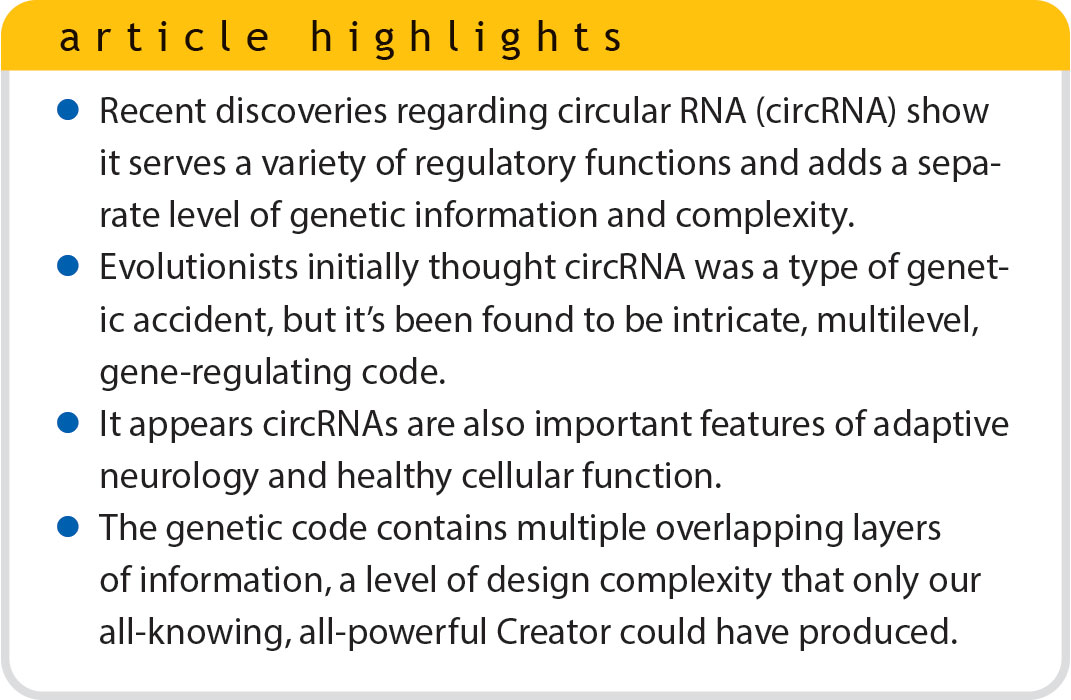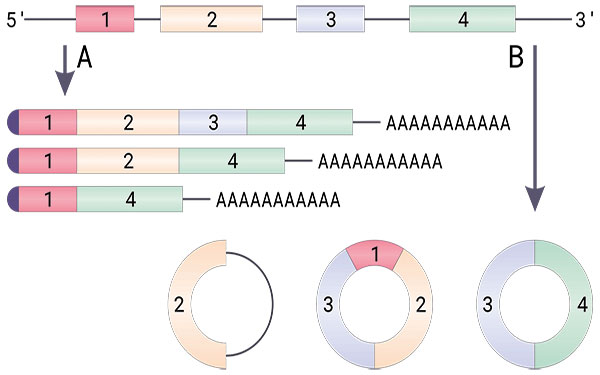
If the regulatory picture of the genome were not complicated enough, over the past decade scientists have discovered another level of Darwinian-defying biocomplexity involving a whole new class of molecules in the form of RNA hoops or circles.1,2 In fact, the findings were so startling that one researcher commented that the molecules form “a hidden, parallel universe” in which many new types and functions remain to be discovered.3 What are these remarkable RNA molecules?
The Growing List of Non-Coding RNAs
Early in the molecular biology revolution of the 1970s, researchers discovered a class of functional molecules in the genome called non-coding RNAs, meaning they do not provide a template for making proteins. The first identified forms of these molecules, transfer RNAs and ribosomal RNAs, are involved in manufacturing proteins. Now scientists have added many more categories of non-coding RNA to the mix. Some are very short, and others are quite long. Many of these new types of RNA are regulatory in nature and are known to be key players in controlling how genes are expressed and controlled in the cell.
The latest addition to this startling array of RNA molecules is truly astounding. Most non-coding RNAs are linear and then fold into specific shapes, and others are integrated into various protein structures. However, this newly characterized type forms loops and circles and is encoded with DNA information that in many cases actually overlaps with protein-coding genes. Thus, it represents a completely separate layer of information overlaid in the same code with genes.
Amazingly, many other types of regulatory RNA are also coded into the same DNA space on chromosomes as the protein-coding genes themselves are. It is now clear that individual genes actually contain many different levels of genetic information, a phenomenon that gradual, neo-Darwinian evolution (random mutation and “selection”) simply cannot account for.
Background
In the genomes of most plants and animals, genes are coded in pieces. The coding regions are called exons, and the coding sequence is interrupted by non-coding regions called introns. As a copy of a gene is being made, the resulting RNA transcripts typically undergo splicing to remove introns and fuse together the exons to form mature linear RNA transcripts known as messenger RNAs (mRNAs).
Splicing is a highly regulated process that may generate multiple mature mRNAs (isoforms) from a given gene in a process known as alternative splicing.4 This transcript diversity is accomplished by omitting some exons or even doubling some, but the same linear order of sequences is always maintained in the original gene. The various transcript isoforms can exhibit different functions, cellular destinations, or regulatory roles. In humans, over 95% of known genes have alternatively spliced isoforms.
Circular RNAs (circRNAs) are generated by a specific type of splicing called back-splicing in which the leading end (5’ terminus) of an unspliced pre-mRNA of an upstream exon is non-colinearly spliced with the trailing end (3’ terminus) of a downstream exon, forming a covalently closed loop.5–8 Upstream and downstream refer to the relative direction in which RNA transcription takes place. After they are produced, circRNAs are mostly found in the cell’s cytoplasm outside the nucleus. Because they are circular molecules instead of a regular linear mRNA produced from the same gene, they are more resistant to degradation by RNA enzymes called RNases.

The existence of circRNAs in mammals was first reported in 1979. The circular molecules were directly observed in the cytoplasm of cultured human cancer cells by electron microscopy.9 However, due to technological limitations, only a few specific circRNAs were characterized over the next several decades, and the potential functions of circRNAs remained unclear.5
With the development of new DNA-sequencing technologies in the early twenty-first century and new techniques in the study of DNA sequence-related data (bioinformatics), scientists have demonstrated that the expression of circRNAs in mammals is a common biological phenomenon that shows tissue and cell specificity.5–8 In fact, the expression level of some circRNAs can be higher than that of the regular linear mRNAs of the genes from which they are derived.
Initial Groundbreaking Discoveries
While numerous circular RNAs have been discovered in the past decade, it’s worth noting several initial discoveries that kicked off this whole field of groundbreaking research. These first research papers helped elucidate the basic mechanisms behind how circRNAs are produced and how they specifically function to regulate gene activity.
In the first two studies, researchers discovered that circRNAs from back-spliced exons can serve a wide variety of regulatory functions. One study showed that they can function as microRNA sponges.1 In a previous article, I discussed the importance of microRNAs. These crucial genetic regulatory molecules control mRNAs in the cell. They can also be heritable and play a key role in epigenentics.10 So, some types of circRNAs can have dozens of target sites for microRNAs and will act like sponges by binding them up and regulating microRNA activity in the cell.
In a different study, researchers demonstrated that another class of circRNAs, also generated from exons, contain numerous binding sites for a type of regulatory protein called RNA-binding proteins, or RBPs.2 Diverse RBPs recognize, bind, and regulate hundreds of mRNA transcripts and form extensive regulatory networks that help maintain cell homeostasis and function.11 Thus, various types of circRNAs act as binding decoys or targets for RBPs as a means to regulate RBP activity. One should recognize these interlocking, RNA-based cellular machinery as highly complex, engineered systems of checks and balances that robustly fine-tune genetic activity within the cell.
Not Junk DNA After All
Another study published about the same time as the two circular RNA studies mentioned above described a third class of circRNAs from entirely unexpected regions of genes.12 These circRNAs are formed from the intron regions inside a gene that were once thought to be junk DNA. As noted above, exons are the regions in the genetic code that remain in the final coding RNA transcript, while introns are the gene regions that are spliced out.
When scientists first discovered large numbers of spliced-out intron fragments, they were baffled since they originally believed that the fragments served no function and should have been degraded by the cell machinery. Now it is known that introns contain many different types of regulatory signals and features that regulate gene function. And like exons, they can be circularized, too.
In these newly identified circular intronic RNAs (ciRNA), the introns are excised from the initial gene transcript into smaller RNA molecules to form circles that enhance the gene’s transcription. The researchers proved this when they were able to “perturb” the action of ciRNAs in cells by inhibiting their function and observing the effect on gene expression. The scientists also found that the ciRNAs promote gene function by associating with the transcription machinery that copies DNA into RNA (RNA polymerase II). Interestingly, these ciRNAs were expressed in particular cell types, further emphasizing that they are specifically controlled and highly functional.12
In contrast to the previously discovered circRNA composed of spliced-gene exons and functioning primarily as microRNA (miRNA) sponges in the cell cytoplasm, ciRNAs act as transcription enhancers in the nucleus.3 In fact, ciRNAs are primarily localized to the nucleus, which contains the cell’s genomic DNA, where they enhance gene expression.
Researchers have actually found a wide variety of regulatory RNA molecules encoded in gene introns, including small nucleolar RNAs (snoRNA), miRNA, and various types of long non-coding RNAs (lncRNA).1 And now scientists can add ciRNAs to the evergrowing list of functional DNA found in introns, creating a picture of complexity in the cell that will certainly increase with time. Clearly, the intron regions that reside inside genes and cover about 20% of the entire human genome are as functionally important to the cell as the protein-coding regions (exons) that cover less than 5% of the genome.1
Recent Circular RNA Research
While our understanding of the regulatory control of circRNAs in gene expression, miRNA binding, and protein binding keeps expanding with new research, other aspects of the inherent coding capacity of these molecules continue to emerge. Two things are especially worthy of note. The first is that these circRNAs themselves can be recoded dynamically to alter their function. In a previous article, I reviewed how transcribed linear RNAs from genes can be recoded dynamically on the fly by changing an adenosine base to an inosine base (A-to-I editing).13 The inosine base, which isn’t part of the standard genetic code, is interpreted as a guanine base at the ribosome where proteins are made. As it turns out, A-to-I editing also occurs in circRNAs.
This leads to the next important recent finding: circRNAs can code for proteins.7,8 Indeed, a 2022 study showed that not only are circRNAs dynamically recoded, but the A-to-I editing also results in the addition of a translational start codon and an entry point for a ribosome to begin translation (protein production).14
Other research demonstrates how circRNAs function in adaptive neurology. The brain’s neural network is composed of neuronal cells, the elongated portion of the nerve cell (axons), and the extracellular junctions of the axons among cells (synapses) that work together to transmit bioelectrical signals across the synapses. Interestingly, a large number of circRNAs are consistently found to be upregulated (increase in gene RNA production) during neuron cell development (neurogenesis), and some circRNAs are also found to be enriched in synapses.6
.jpg)
These neurologically connected circDNAs have been found in the brains of nematodes (small worms), pigs, mice, and humans.7 Since neurological function is closely related to behavioral traits and is also associated with rapid adaptive responses, it is logical to postulate that circRNAs are important molecular systems related to creature adaptation.
Recent research also shows that circRNAs can be encapsulated in lipid-bound capsules called vesicles and exported out of the cell.6 Initial studies describing this mechanism speculated that it functions as a clearance mechanism to remove overly abundant circRNAs from the cell. However, follow-up research showed that these exported circRNAs remain intact and can be taken up by other recipient cells as a way to facilitate cell-to-cell communication.6
Another line of research related to human health emphasizes the importance of circRNAs in cell biology.6 To date, aberrant levels of cellular circRNAs have been implicated in a variety of diseases, including diabetes, chronic inflammatory disease, and cancer. Incredibly, dramatic shifts in circRNA levels have also been connected to aging.6
This research makes it clear that circRNAs are important features of healthy cellular function. At the time of this writing, over 100,000 different circRNAs have been discovered, but they remain very understudied compared to other systems and features of gene expression.6
.jpg)
Conclusion
In their anti-design mindset, evolutionary scientists first thought that circRNAs were genetic accidents or experimental artifacts. However, these errant hypotheses have been dismantled as discoveries progressed to reveal complex cellular design and control systems that simply boggle the mind. After over a decade of research, it is now certain that circRNAs are important functional components of gene regulation and protein production. Indeed, the field of circRNA research has revealed many different categories of circRNAs that exhibit control over gene expression in the nucleus, protein production in the cytoplasm, and intercellular communication in the body.
After the initial wave of discoveries for circRNA functionality, prominent molecular biologist Erik Sontheimer exclaimed, “You just wonder when these surprises are going to stop.”3 The ensuing decade of circRNA research since Sontheimer made this comment has not only revealed many more crucial functions of circRNAs but has also shown that they are invaluable regulatory mechanisms within and between cells, governing a broad range of gene expression and protein production activity.
These circRNAs embedded inside both the coding and non-coding segments of genes continue to reveal the amazing complexity of the genetic code that exists in multiple overlapping layers of information. This code complexity utterly defies the Darwinian myth that accidental mutations and an impersonal, mythical selective agent (natural selection) magically created them. Instead, the complexity of this multilayered code and cellular control systems speaks loudly of design by the omnipotent and omniscient Creator, the Lord Jesus Christ.
References
- Hansen, T. B. et al. 2013. Natural RNA Circles Function as Efficient microRNA Sponges. Nature. 495 (7441): 384–388.
- Memczak, S. et al. 2013. Circular RNAs Are a Large Class of Animal RNAs with Regulatory Potency. Nature. 495 (7441): 333–338.
- Ledford, H. 2013. Circular RNAs Throw Genetics for a Loop. Nature. 494 (7438): 415.
- Braunschweig, U. et al. 2013. Dynamic Integration of Splicing Within Gene Regulatory Pathways. Cell. 152 (6): 1252–1269.
- Yu, C.-Y. and H.-C. Kuo. 2019. The Emerging Roles and Functions of Circular RNAs and Their Generation. Journal of Biomedical Science. 26 (29).
- Kristensen, L. S. et al. 2019. The Biogenesis, Biology, and Characterization of Circular RNAs. Nature Reviews Genetics. 20 (11): 675–691.
- Yang, L., J. E. Wilusz, and L.-L. Chen. 2022. Biogenesis and Regulatory Roles of Circular RNAs. Annual Review Cell Developmental Biology. 38: 263–289.
- Liu, C.-X. and L.-L. Chen. 2022. Circular RNAs: Characterization, Cellular Roles, and Applications. Cell. 185 (12): 2016–2034.
- Hsu, M.-T. and M. Coca-Prados. 1979. Electron Microscopic Evidence for the Circular Form of RNA in the Cytoplasm of Eukaryotic Cells. Nature. 280 (5720): 339–340.
- Tomkins, J. P. 2024. Small Heritable RNAs Pack a Big Adaptive Punch. Acts & Facts. 53 (1): 12–15.
- Gebauer, F. et al. 2021. RNA-Binding Proteins in Human Genetic Disease. Nature Reviews Genetics. 22 (3): 185–198.
- Zhang, Y. et al. 2013. Circular Intronic Long Noncoding RNAs. Molecular Cell. 51 (6): 792–806.
- Tomkins, J. P. 2024. RNA Editing: Adaptive Genome Modification on the Fly. Acts & Facts. 53 (2): 14–17.
- Welden, J. R. et. al. 2022. RNA Editing of Microtubule-Associated Protein Tau Circular RNAs Promotes Their Translation and Tau Tangle Formation. Nucleic Acids Research. 50 (22): 12979–12996.
*Dr. Tomkins is a research scientist at the Institute for Creation Research and earned his Ph.D. in genetics from Clemson University.














